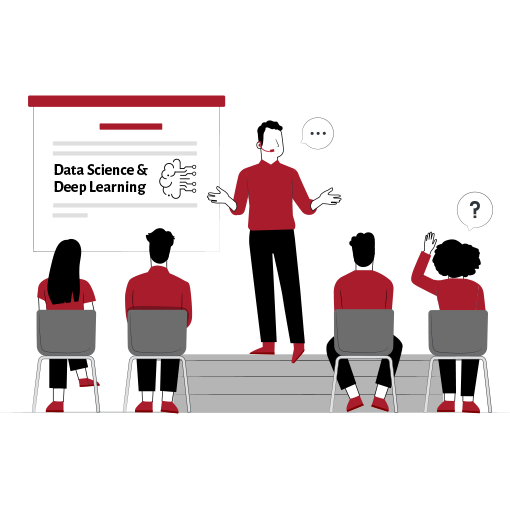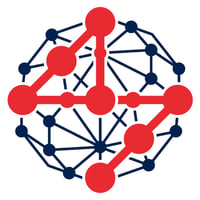Mastering Data Science With Deep Learning
Deep learning is an important part of data science training program, which covers statistics and predictive modeling. It is highly advantageous to data scientists who are responsible with gathering, analyzing and interpreting enormous volumes of data; deep learning makes this process faster and easier.
According to Kaggle, a subsidiary of Google LLC, 36% of data scientists prefer the R programming language for data science work.

Class Introduction
-
Without data science, enterprises of all kinds, especially huge corporations, would have difficulties making educated decisions.
-
Mastering Applied Data Science + Deep Learning is a project-driven course that will teach students the practical aspects of Data Science.
-
Collecting data by web scraping, validation of information in data by data analysis, comparing models created by ML and DL algorithms by interpreted metrics, and more.
-
Additionally, we proceed into the more enhanced portions of data science by introducing areas, such as recommender systems, natural language processing (NPL), Deep Learning, and Computer Vision, which are employed in everyday applications of AI.
Program Highlight Overview:
-
1
-Pre-Work
Python, Stats, SQL, Web.
-
2
-Student Portfolio development
LinkedIn, blog, GitHub, Masterminds, data story telling, partner corporations introductions and networking.
-
3
-Machine Learning
Includes Advanced ML with 3 PBL Projects, and 2 Kaggle Challenges.
-
4
-Deep Learning
Major 3 Libraries: Theano, TensorFlow and Keras, NLP using Dl, NLP Times series.
-
5
-Big Data & AWS Platform
ML Modeling Spark, Splunk, AWS AMI Deep Learning, NLP.
Get In Touch
Class Duration: 16 Weeks
Days:
Monday/Wednesday/Sunday or Saturday/Sunday (weekday office and mentoring hours are available)Saturday & Sunday (weekday office and mentoring hours are available)
Time:
Monday/Wednesday - 5pm-9pm; Saturday/Sunday - 10am – 6pm
Locations:
Los Angeles - CA, Irvine - CA, San Diego - CA, Walnut Creek - CA, Lacey - WA
Price: $14,995 (Financial options available)
Prerequisites and Requirements:
Yes, Pre-Work is required, included in the price.
Do you offer a Certificate?
Yes, at completion you will receive a certificate from theDevMasters showcasing the 500 hours you've completed in our nationally recognized course!

Why opt this class?
-
In-person Training
-
Applied Labs: an Innovative Way to Learn
-
100% Hands-On Learning
-
Project Based Learning
-
Mastermind Project Groups and Interview Prep Groups
-
Repeat Project or Session Anytime
Related Courses
Python 101, Stats 101, SQL, Web 101, delivered as PreWork to this course.
Teachers & Credentails:
Zia, Sidy, Jay, Kate, Mohammad Arshad.Average Salary Post Graduation:
Refer Glassdoor: $115k in Los Angeles area.
Why you should take this class?
This class is open for all backgrounds; there is a pre-requisite which is completed through Pre-Work to assure students are setup for success.
-
Someone looking to change their career,
-
Someone looking to improve their knowledge and gain skills to become a leader and leverage themselves in the chosen field.
-
College students and recent graduates looking for hands-on experience and to fill the gap between school and real world applications.
Our graduates backgrounds include: marketing, engineering, healthcare services, insurance, education, real estate, manufactuing, e-commerce, sports, on demand services, etc.
Class Size:
5:1, student-to-teacher ratio.
Mastering Data Science Applied Labs PreWork
Whether you are familiar with programming or not, our Python PreWork sessions introduce the fundamentals of Python, such as variables, string fundamentals, if-else statements, try & except statements, for loops, while loops, break & continue statements, & lambda functions, as well as certain data types relevant to data science, like lists, tuples, dictionaries, & sets for beginning exposure. The activities done in these sessions will be guides to student’s questions moving forward in the classes.
The hands-on portion of statistics in PreWork is to establish the surface level understanding of concepts such as mathematical variables, like numerical vs categorical, nominal vs ordinal, interval vs discrete; measurements of statistics, like when to use mean, when to consider median, & when to revised to mode; relationship between variables, like correlation & independence; ending with hypothesis testing & p-value, but only to the degree of applying the mindset towards data science. These concepts will be reviewed in the program to ensure that student’s clarifications are addressed.
While some of the tools used in Python will take the place of SQL functions & methods, it is still beneficial to understand the origins of these tools as well as be able to replicate them when applied in future work’s expectations. A solid portion of demand in data science jobs ask for big-query experience with SQL, like Microsoft SQL & PostgreSQL vs NoSQL, like MongoDB & DynamoDB, which we will glimpse at scenarios to further solidify the students’ candidacy.
An introduction to HTML & CSS is key to future project building & publications of the blog posts of student progress throughout the program. A proportion of relevant data is out there in the web for us to utilize & using the most open source methods, like HTML & CSS to be able to grab that information within our Python environments will be introduced in Day 3 & furthermore, once students are in Project Based Learning, GitHub portfolios are best displayed in themes that students choose & customize with HTML & CSS.
Applied Labs
-
Session I: Introduction to Data Science with Python
In our first class, we will go over some intermediate functions in Python as review & move onto introducing what is the expected mindset of a data scientist versus the traditional viewpoint & how to take full advantage of the program by using the Applied Labs environment. We will encourage students to introduce themselves to each other & gather each other’s strengths, along with the instructor’s experience to not only grasp the skills & tools a data scientist is expected to know, but know exactly when to use which tools & why through peer & real-life learning. There will also be an introduction to the CRISP-DM data science methodology & chosen framework with the distinctions between the two mindsets of machine learning: supervised learning & unsupervised learning. The session has two miniature projects, Temperature & Christmas, to wrap up Python essentials
Project 1: How Much Longer Until Christmas? -
Session II: Exploratory Data Analysis
We start by asking the questions that data science can help answer for students to identify the difference between a data analytical question vs a data science question. We further breakdown what are the key checklist items in form of questions that CRISP-DM individual stages require before moving further in the cycle. We again showcase the peculiarities between supervised learning & unsupervised learning & explain why sometimes supervised learning is the method that most of us will encounter, but unsupervised learning will elaborate more patterns in data than we can ever imagine. We introduce the self-checking mindset of what is considered good data for data science projects: what is good data & how can we detect bad data from good data, & we let the students ponder how we can tackle dirty data. We then give the attributes to help students identify big data from small data through the four V’s. A small review on what are the differences between mathematical variables, numerical vs categorical along with a short case of where statistics are required the most in data science: the data analysis phase. The hands-on portion of the class familiarizes students with NumPy and Pandas and showcasing how to clean, manipulate, and analyze data by applying those concepts. Students will be given the data set for Titanic, a Kaggle competition known for introductory data science methods & cleaning, practicing data analysis skills on the Titanic dataset with Pandas to get students in the data science mindset of resultoriented, instead of process-oriented.
Project 2: Exploration of Titanic -
Session III: Data Visualization & Information Analysis
We start off by asking what is the purpose of visualization in data science, broadening on student’s experiences with charting & decision making with charts. A review of NumPy functions for generating different types of data is done before a brief introduction to Matplotlib’s figure attributes & properties. Instructors will continue with explaining what are the most common analysis-based visuals, such as histograms & scatterplots. An intermediate approach to Titanic is used for exercises with graphing in Matplotlib & analyzing whether the graph is deemed useful or not. We continue with creating a Python-based method for web-scraping & introduction to JSON. There are further functions & helpful tips to consider analyzing data with Pandas, such as common Excel functions implemented to insights. The day ends with a project on what happened during the 2012 election & whether the data of polls can give us clues into who was more likely to win. A GitHub repository is expected to be created by the end of this session & students will learn how to create their own blog & begin to publish content.
Project 3: Election Day Results -
Session IV: Machine Learning
We will review by explaining the difference between supervised learning and unsupervised learning, asking students why certain scenarios will not be effective for supervised learning. Furthermore, an explanation on the two result-oriented methods of supervised learning, regression & classification are distinctly introduced. The day is dedicated to determining a regression problem, immediate analysis to modeling using regression methods, assessing the models, then optimizing for the best results by different metrics. Afterwards, students will work on building one of the regression models introduced, such as linear, polynomial, ridge, lasso, gradient, robust, & an introduction to logistic regression for classification. The day end with a Kaggle based project using regression.
Project 4: Optimizing House Price Prediction -
Session V: Advanced Machine Learning
Revisiting the results that students ended their House Pricing project with, we will give more hints & clues to how to approach the project further. We will then dive into the second supervised learning need: classification algorithms, such as Naïve Bayes, Decision Trees, Random Forest, and other methods based on regression. Students are expected to be able to identify when a certain algorithm will be used based on the data & which methods to optimize classification algorithms further to what is appropriate for insights & decisions. Students will also learn metrics such as R-squared, MSE & RMSE, & scoring using precision, recall, sensitivity, specificity, and accuracy score, AUC, and ROC, along with gains & lift charts. The session ends with a Spam Classifier project, which eludes to the processes of Natural Language Processing.
Project 5: Classification of Spam Emails -
Session VI: Hack Day
Students will be separated into two groups & able to truly practice their skills, emphasizing on visualization & modeling with machine learning, with a live Kaggle competition. During this time working with others, students will also be encouraged to identify the gaps in their skills, especially in analysis & modeling, in the project & review as much as possible moving forward to other projects in the continual sessions.
Project 6: Baseline Kaggle Competition
Project Based Learning Level - One
Students will apply the Cross Industry Standard Process for Data Mining (CRISP-DM) standard in a provided data set to understand the process behind starting a new project. We will recommend individual students to tackle different aspects of CRISP-DM that need more practice in, such as visualization, data understanding, or modeling.
Students will undertake a new project from start to finish. This project will allow students to demonstrate their skills in data acquisition, data cleaning, data enrichment, modeling, evaluation, and deployment.
As a third project, theDevMasters encourages students to bring their own data in their chosen domain for additional mentoring. Since these projects might entail more opinions & guidance, theDevMasters will proceed to transfer the third project over to the Mastermind group.
Project Based Learning Level - Two
Students will apply the Cross Industry Standard Process for Data Mining (CRISP-DM) standard in a provided data set to understand the process behind starting a new project. We will recommend individual students to tackle different aspects of CRISP-DM that need more practice in, such as visualization, data understanding, or modeling.
Students will undertake a new project from start to finish. This project will allow students to demonstrate their skills in data acquisition, data cleaning, data enrichment, modeling, evaluation, and deployment.
As a third project, theDevMasters encourages students to bring their own data in their chosen domain for additional mentoring. Since these projects might entail more opinions & guidance, theDevMasters will proceed to transfer the third project over to the Mastermind group.
Project Based Learning Level - Three Advance Expertise using Deep Learning
-
Deep Learning mastering Theano, TensorFlow and Keras libraries
-
Develop Large Models on GPUs Cheaply In the Cloud
-
Crash Course In Multilayer Perceptrons
-
Develop Your First Neural Network With Keras
-
Evaluate The Performance of Deep Learning Models
-
Use Keras Models With Scikit-Learn For General Machine Learning
Advanced Multilayer Perceptrons and Keras
-
Save Your Models For Later With Serialization
-
Keep The Best Models During Training With Checkpointing
-
Understand Model Behavior During Training By Plotting History
-
Reduce Overfitting With Dropout Regularization
-
Lift Performance With Learning Rate Schedules
Convolutional Neural Networks
-
Course In Convolutional Neural Networks
-
Project Object Recognition in Photographs
Recurrent Neural Networks
-
Course In Recurrent Neural Networks
-
-
Deep Learning for Natural Language Processing
Develop Deep Learning Models With Keras
-
Develop a Neural
-
Bag-of-Words Model for Sentiment Analysis
-
Develop Word
-
Embeddings with Gensim
Neural Language Modeling
-
Develop a Word-Based Neural Language Model
-
Neural Image Caption Generation
-
Neural Network Models for Caption Generation
-
Load and Use
-
Pre-Trained Object
-
Recognition Model
Machine Translation
-
Neural Machine Translation
-
Encoder-Decoder Models for Neural
-
Machine Translation Configure
-
Encoder-Decoder Models for Machine Translation
-
-
Deep Learning for Time Series Forecasting
Taxonomy of Time Series Forecasting Problems
-
Develop a Skillful Forecasting Model
-
Transform Time Series to a Supervised Learning Problem
Simple and Classical Forecasting Methods
-
Prepare Time Series Data for CNNs and LSTMs
Develop LSTMs for Time Series Forecasting
-
Grid Search Deep
-
Learning Models for Univariate Forecasting
-
PBL- Business Focus Deep learning
-
Business Focus Deep Leaning Level 1 Deployment
Using Theano, TensorFlow and Keras libraries
-
Project 1: Object Recognition in Photographs
-
Project 2: Sentiment From Business Reviews Box
-
-
Business Focus Deep Leaning Level 2 Deployment
Deep learning with Natural Language process
-
Project 1: Develop a Neural Language Model for Text Generation
-
Project 2: Prepare a Photo Caption Dataset For Modeling
-
Project 3: Develop a Neural Image Caption Generation Model
-
-
Business Focus Deep Leaning Level 3 Deployment
Deep learning with Time Series
-
Project 1: Explore Household Energy Usage Data
-
Project 2: Text Generation With Alice in Wonderland
-

Transforming Businesses Globally Through Generative AI
Arshad K. (Founder)